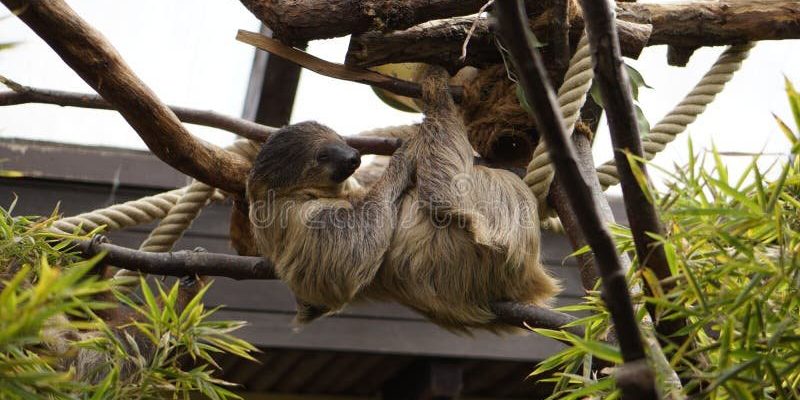![Comparing The Two-Toed Sloth Vs. [Similar Species]](https://gudri.com/wp-content/uploads/2025/06/Comparing_The_Two_Toed_Sloth_Vs___Similar_Species__image_0.jpg)
Imagine sitting in a cozy cafe, sipping your favorite drink, and chatting about these fascinating creatures. You might be wondering why sloths are so unique and what sets these two types apart. Well, let’s break it down.
What Makes Sloths So Special?
Sloths are known for their laid-back lifestyle and adorable, sleepy faces. They spend most of their time hanging upside down from trees in the tropical forests of Central and South America. Despite their slow movements, they play a crucial role in their ecosystem, helping to maintain the health of the trees they inhabit.
Both the two-toed and three-toed sloths belong to the same order known as Pilosa, but they fall under different families. The two-toed sloth, belonging to the family Megalonychidae, has—surprise!—two toes on its front limbs, while the three-toed sloth, part of the family Bradypodidae, has three. This simple difference leads to many other fascinating distinctions between the two types.
Physical Differences Between Two-Toed and Three-Toed Sloths
When you look closely, the differences between the two-toed sloth and the three-toed sloth become stark. The most noticeable difference is, of course, the number of toes. The two-toed sloth has two clawed toes on each of its front limbs, while its three-toed cousin has three clawed toes.
In terms of size, two-toed sloths tend to be larger and bulkier than three-toed sloths. On average, a two-toed sloth can weigh up to 15-20 pounds, while three-toed sloths usually weigh around 8-10 pounds.
Furthermore, two-toed sloths are often brownish-gray and have a coarser fur texture. In contrast, three-toed sloths usually display a blend of light and dark colors with a softer fur that can appear a bit fuzzy. With the differences in their fur, you might even think of the two-toed sloth as the rugged outdoorsy type, while the three-toed sloth feels a bit more like the whimsical artist.
Behavior and Lifestyle: A Deeper Look
Speaking of behavior, the two-toed sloth and three-toed sloth have different personalities. Two-toed sloths are known to be more active and even somewhat aggressive, especially when they feel threatened. They tend to eat more than three-toed sloths, feeding on a wide variety of leaves, fruits, and occasionally even insects.
On the other hand, three-toed sloths are generally more relaxed and docile. They prefer a diet that consists primarily of leaves and are less likely to venture out of their treetops. Their slower pace is a survival tactic; by moving slowly, they reduce their chances of being spotted by predators like jaguars and eagles.
Habitat: Where Do They Live?
Now let’s talk about where these sloths call home. Both types of sloths are found in tropical regions, but their habitats can differ slightly. The two-toed sloth primarily inhabits the lowland rainforests, while three-toed sloths are more commonly found in both rainforests and cloud forests at higher elevations.
They both excel at climbing trees, but their preferred trees may vary. For instance, the two-toed sloth enjoys trees with strong, sturdy branches, allowing them to hang out comfortably. Three-toed sloths might be found nestled among the softer, more flexible trees that provide them with plenty of leaves to munch on.
Reproduction: Baby Sloths and Their Care
When it comes to family life, both two-toed and three-toed sloths have interesting approaches to raising their young. Female sloths typically give birth to a single baby after a gestation period of about six months.
The two-toed sloth’s baby is born with fur and eyes open, making it ready to cling onto the mother’s back almost immediately. In contrast, three-toed sloth babies are born hairless and are entirely reliant on their mothers for warmth and food during the first few weeks.
Interestingly, mothers of both species are very protective. They often carry their young everywhere they go, teaching them the ropes of sloth life. You might imagine a baby sloth clinging on for dear life, cozy and safe, while mom navigates the treetops with ease.
Conservation Status: Are Sloths at Risk?
Now, this is an important part of the discussion. Both two-toed and three-toed sloths face threats, primarily due to habitat destruction. Deforestation and urbanization are significant issues, leading to declining populations.
While three-toed sloths are currently listed as vulnerable, two-toed sloths are classified as least concern, which means they’re not facing the same immediate dangers—yet. However, it’s crucial to keep an eye on both types, as the conservation status can quickly change with environmental shifts and climate change.
Organizations are working hard to raise awareness and protect these gentle creatures. Whether through rescuing injured sloths or advocating for forest preservation, there’s plenty of hope and help on the horizon.
Cultural Impact: Sloths in Our Hearts
Last but not least, let’s explore how sloths have made a mark on popular culture. They have become symbols of relaxation, representing the importance of taking it slow in a fast-paced world. Whether you’ve seen them in viral videos or adorable memes, sloths have captured hearts everywhere.
In many ways, their charm comes not only from their unique appearance but also from their laid-back demeanor. Two-toed and three-toed sloths have created roles for themselves in movies, TV shows, and even merchandise.
There’s something we can all learn from sloths—embracing our slower moments and taking a break from the hustle and bustle of life.
As we wrap up our comparison of the two-toed sloth and the three-toed sloth, it’s clear that both species bring something unique to the table. From their physical differences to their behaviors and habitats, sloths are truly fascinating creatures.
Whether you find yourself captivated by the two-toed sloth’s robust nature or the gentle charm of the three-toed sloth, it’s evident that these creatures deserve our attention and protection. Remember, every little effort counts when it comes to keeping our planet’s biodiversity thriving. So, next time you see a sloth—whether in person or on the screen—take a moment to appreciate their beauty and the differences that make them all the more special!

